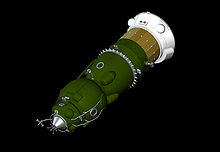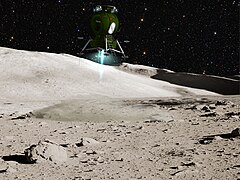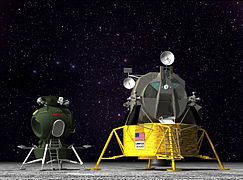Soviet manned lunar program
The Soviet manned lunar program was the unsuccessful attempt by Soviet space travel to forestall the US in the race to the moon .
After the successful space probe programs Lunik from 1959 and Luna from 1963, a cosmonaut was supposed to be the first person to land on the moon . The Soviet lunar program was top secret until the glasnost period. Details about this became known only after 1990.
Split into two projects
On August 1, 1964, by decree 655-268 of the Council of Ministers, the Soviet manned lunar program was split into two projects:
- with the designation LK-1 (UR-500 / LK-1) or later L-1 (UR-500 / L1 or also Zond ) ran a fly-around program in the space company OKB-52 of the designer Vladimir Nikolayevich Tschelomei .
- The Group OKB-1 by Sergei Korolev won with his project N1-L3 the contract for the moon landing.
With effect from December 25, 1965, the UR-500 / LK-1 project was transferred to the UR-500 / L1 project and thus became Koroljows OKB-1. Even so, the program remained divided into two largely independent projects that benefited little from each other. Ultimately, only Block D , largely different versions of the command capsule of the Soyuz spaceship and the SAS rescue system, were used together . The originally planned but never completed spaceship LK-1 was even a completely independent development of Tschelomei's OKB-52.
UR-500 / L1 lunar flyby
Due to the limited payload capacity of the Proton launch vehicle (UR-500K), a special two-seater version of the Soyuz spaceship without orbital section called the 7K-L1 should be used for manned orbiting the moon . Because of the low fuel supply of this combination, it was not possible to enter lunar orbit. The spaceship should therefore only make a flyby and then return to Earth.
From 1968 to 1970 unmanned test flights were undertaken under the designations Zond 4 to Zond 8. Sometimes animals were taken along to see how they react to weightlessness . Of these flights, only Zond 7 and Zond 8 ran as planned; others were only partially successful or proved to be total failures. The UR-500 / L1 combination demonstrated its technical qualifications with the two flights of Zond 7 and Zond 8, but with a three-year delay and only after NASA's moon landings in 1969.
A total of three manned flights were planned, which should originally take place from August to October 1967. The program was delayed by three years due to enormous technical defects on the Proton and also on the spaceship. As usual in the Soviet space program, cosmonaut groups were trained, but no fixed assignment of space travelers and certain flights was made. After NASA had circled the moon several times with Apollo 8 in December 1968 and landed on the moon with Apollo 11 , the manned flights were canceled.
Moon landing program N1-L3
technology
Launch vehicle N1
The payload of 5 t of the R-7 previously used in the manned program was far from sufficient for a manned mission . With the large rocket N1 should now be 95 t achieved, comparable to the 133 t of American moon rocket Saturn V . Due to the lower payload, all sub-projects came under the pressure of mass reduction. This, in turn, was at the expense of the redundancy and reliability of the subsystems. Reserves (which cost mass), as they were available for the successful rescue of the crew in Apollo 13, for example , were virtually non-existent when the original N1 was used.
The development of the N1 suffered mainly from the fact that no suitable large engines like those of the Saturn V were available or were being developed. Of the planned Kuznetsov NK-15 engines with 1.44 MN thrust each (improved NK-33 engines were planned for take-offs from 1974), 30 pieces had to be used in parallel, which required complex control, fuel supply and novel dynamic problems. There was also neither sufficient time nor funds to build a first stage test bench. After four false starts between 1969 and 1972, the N1 development program in 1974 and the manned lunar landing project based on it were finally discontinued.
Spaceship 7K-LOK (L3)
The LOK ( Lunnyi Orbitalnyi Korabl 'moon orbital spaceship ') was a further development of the Soyuz spaceship . Like this, it consisted of three parts:
- The spherical orbital section, which had an additional powerplant at the bow.
- The bell-shaped, aerodynamic return capsule , which had a stronger heat shield due to the higher re-entry speed .
- Compared to the Soyuz, the larger equipment section with tanks, fuel cells and engines.
As with the Apollo spacecraft, the energy should be supplied by fuel cells and not with solar booms, as with the Soyuz spacecraft. The lunar orbital spaceship should have space for two people and weigh about ten tons.
Lunar Module LK
Only a few technical details are known of the Lunniy Korabl ("moon ship", LK), the Soviet lunar lander: It was 5.20 m high and consisted of a 1440 kg spherical cabin module, a 2950 kg engine block ( Block E. ) and a 1260 kg landing gear. It weighed just a third of its American counterpart and only had room for one cosmonaut . In contrast to the Apollo lunar module, the LK had a single-stage design: when starting back from the moon, only the landing gear should remain.
The moon lander, camouflaged as a Kosmos satellite, was tested three times unmanned in Earth orbit : Kosmos 379 in November 1970, Kosmos 398 in February 1971 and Kosmos 434 in August 1971. The launches were carried out with Soyuz-L rockets, one specially designed for this purpose customized version of the Soyuz missile. The tests were successful and the lander was the only part of the Soviet moon landing project to be operational, but never flew to the moon.
Today there is a replica of the lander in Euro Disney near Paris .
Spacesuit
A spacesuit was also developed for the moon mission, which was supposed to protect the cosmonaut when he was on the moon. In contrast to the American model, entry was provided from the rear. For this purpose, the life support unit could be folded away. A completed model is on display at the National Air and Space Museum in Washington, DC ( USA ).
Planned course of the mission
After the launch, the spacecraft LOK and the ferry LK were to fly to the moon together with the special drive blocks G and D ( block D is still used in the Proton rocket today) and swivel into orbit there. The landing cosmonaut would have switched to the LK through an outboard maneuver and would have decoupled it together with Block D, which would have applied the majority of the braking deceleration required for the landing. Block D was to be dropped 4 km above the surface of the moon and the lunar module would have braked further with its own drive system (block E) until it touched down.
After a stay of 24 hours and a lunar walk of six hours, the LK would have started with its own drive system in a low lunar orbit and should have been coupled with the orbital ship there. After the landing cosmonaut had transferred, it should be brought to a crash and the LOK should then return to earth with both cosmonauts.
see also: LK-700
Preparations of the crews and expiry of the program
Some candidates, including Alexei Leonov , Pavel Popovich and Valeri Bykovsky , were selected to train for the moon flights. With the successful flight of Zond 8, the project of the moon flyby reached operational readiness in autumn 1970, but after the successful Apollo missions from December 1968 all manned flights were canceled. The UR-500 / L1 project thus ended in 1970 without a successful conclusion on the instructions of the political leadership, despite the technical possibilities now available.
In the lunar landing project, only the lander achieved its flight qualification. At the time of the successful Apollo 11 mission in July 1969, a Soviet landing was not expected until 1972 at the earliest (and thus four years later than originally planned by Korolev) due to the difficulties with the N1 launch vehicle. From January 1970 , the USSR concentrated increasingly on the development of the Salyut space stations in order to forestall the Americans, whose Skylab program was already known, in this area at least . Nevertheless, cosmonauts were still training for the moon landing until October 1973. They wanted to outflank the Americans retrospectively with a planned moon station. This project was finally discontinued in 1974 after Wassili Mishin was replaced by Valentin Gluschko and the former ZKBEM (formerly OKB-1) was converted into the NPO Energia organization . At that time, the first Soviet manned moon landing was scheduled for mid to late 1975.
In contrast to the manned lunar program, the unmanned exploration of the moon by the Soviet Union was quite successful. With Luna 9 achieved in February 1966, the first soft landing on the moon, with Lunokhod 1 , the first lunar vehicle was used in November 1970th Luna 16 was the first unmanned mission to bring lunar rocks to Earth in September 1970, but this was after the US manned moon landing in July 1969.
gallery
Successor program
Russia has been preparing a follow-up program since the 2000s. Initially, a collaboration with ESA was planned; In 2009, Russia decided to continue the project on its own and began developing a suitable spaceship, which today bears the name Federazija . Moon landings and, in the long term - in the 2030s - the establishment of a moon base are aimed for. The decision to start a 20-year moon flight program is to be made in 2019 [out of date] .
See also
literature
- Philipp Meuser: Galina Balaschowa: architect of the Soviet space program . DOM publishers, Berlin 2014. ISBN 978-3-86922-345-2 .
- Eugen Reichl: Moscow's lunar program. Motorbuch Verlag, Stuttgart 2017, ISBN 978-3-613-04027-4 .
Web links
Individual evidence
- ↑ Why the Soviets Lost the Moon Race on airspacemag.com (accessed October 25, 2019)
- ^ Anatoly Zak: ACTS / PPTS development during 2008. In: Russian Space Web. Retrieved July 17, 2019 .
- ↑ Cosmonauts to learn making in-flight decisions without commands from Earth. TASS, April 12, 2019, accessed April 28, 2018 .








